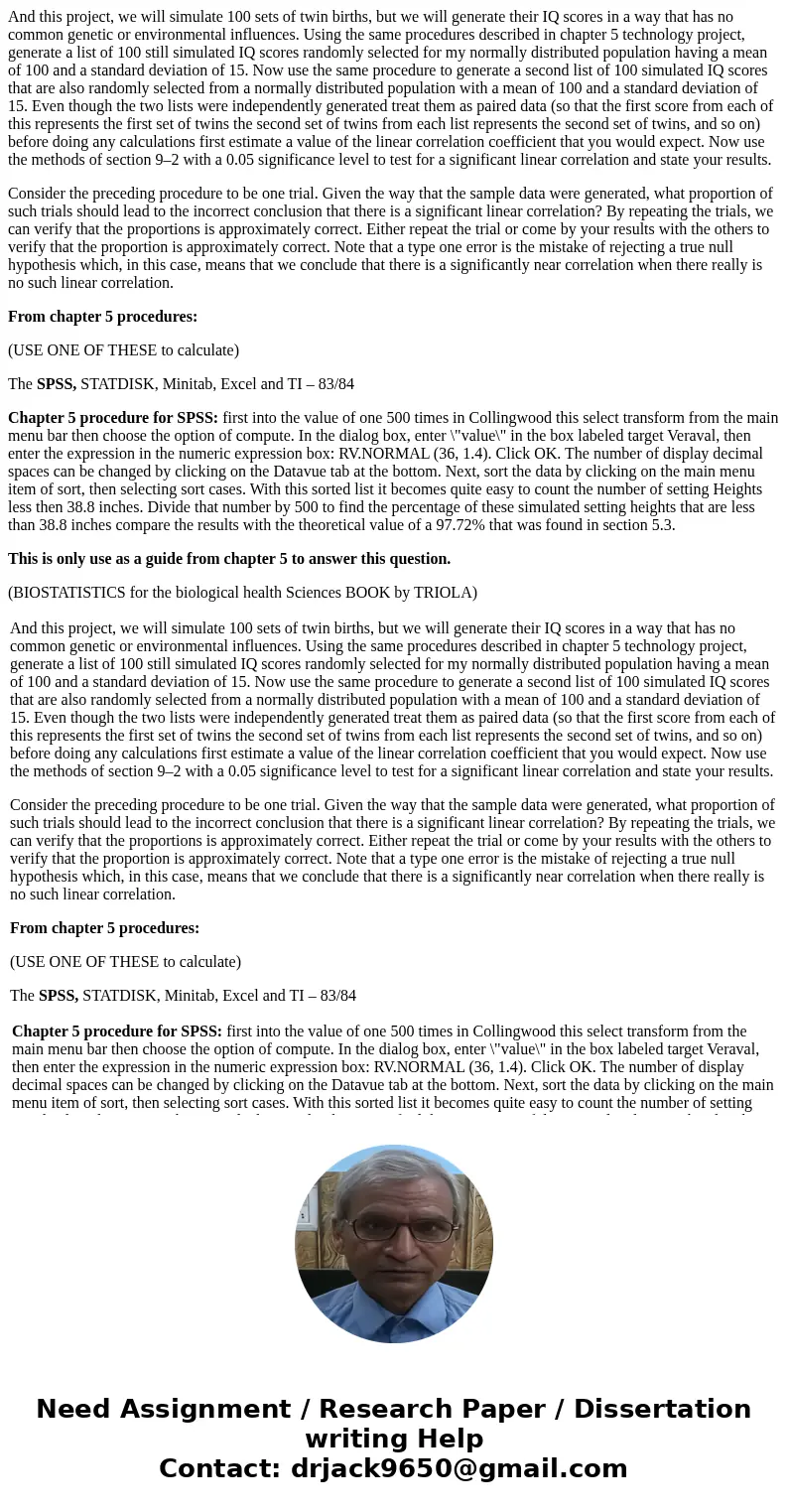And this project we will simulate 100 sets of twin births bu
And this project, we will simulate 100 sets of twin births, but we will generate their IQ scores in a way that has no common genetic or environmental influences. Using the same procedures described in chapter 5 technology project, generate a list of 100 still simulated IQ scores randomly selected for my normally distributed population having a mean of 100 and a standard deviation of 15. Now use the same procedure to generate a second list of 100 simulated IQ scores that are also randomly selected from a normally distributed population with a mean of 100 and a standard deviation of 15. Even though the two lists were independently generated treat them as paired data (so that the first score from each of this represents the first set of twins the second set of twins from each list represents the second set of twins, and so on) before doing any calculations first estimate a value of the linear correlation coefficient that you would expect. Now use the methods of section 9–2 with a 0.05 significance level to test for a significant linear correlation and state your results.
Consider the preceding procedure to be one trial. Given the way that the sample data were generated, what proportion of such trials should lead to the incorrect conclusion that there is a significant linear correlation? By repeating the trials, we can verify that the proportions is approximately correct. Either repeat the trial or come by your results with the others to verify that the proportion is approximately correct. Note that a type one error is the mistake of rejecting a true null hypothesis which, in this case, means that we conclude that there is a significantly near correlation when there really is no such linear correlation.
From chapter 5 procedures:
(USE ONE OF THESE to calculate)
The SPSS, STATDISK, Minitab, Excel and TI – 83/84
Chapter 5 procedure for SPSS: first into the value of one 500 times in Collingwood this select transform from the main menu bar then choose the option of compute. In the dialog box, enter \"value\" in the box labeled target Veraval, then enter the expression in the numeric expression box: RV.NORMAL (36, 1.4). Click OK. The number of display decimal spaces can be changed by clicking on the Datavue tab at the bottom. Next, sort the data by clicking on the main menu item of sort, then selecting sort cases. With this sorted list it becomes quite easy to count the number of setting Heights less then 38.8 inches. Divide that number by 500 to find the percentage of these simulated setting heights that are less than 38.8 inches compare the results with the theoretical value of a 97.72% that was found in section 5.3.
This is only use as a guide from chapter 5 to answer this question.
(BIOSTATISTICS for the biological health Sciences BOOK by TRIOLA)
| And this project, we will simulate 100 sets of twin births, but we will generate their IQ scores in a way that has no common genetic or environmental influences. Using the same procedures described in chapter 5 technology project, generate a list of 100 still simulated IQ scores randomly selected for my normally distributed population having a mean of 100 and a standard deviation of 15. Now use the same procedure to generate a second list of 100 simulated IQ scores that are also randomly selected from a normally distributed population with a mean of 100 and a standard deviation of 15. Even though the two lists were independently generated treat them as paired data (so that the first score from each of this represents the first set of twins the second set of twins from each list represents the second set of twins, and so on) before doing any calculations first estimate a value of the linear correlation coefficient that you would expect. Now use the methods of section 9–2 with a 0.05 significance level to test for a significant linear correlation and state your results. Consider the preceding procedure to be one trial. Given the way that the sample data were generated, what proportion of such trials should lead to the incorrect conclusion that there is a significant linear correlation? By repeating the trials, we can verify that the proportions is approximately correct. Either repeat the trial or come by your results with the others to verify that the proportion is approximately correct. Note that a type one error is the mistake of rejecting a true null hypothesis which, in this case, means that we conclude that there is a significantly near correlation when there really is no such linear correlation. From chapter 5 procedures: (USE ONE OF THESE to calculate) The SPSS, STATDISK, Minitab, Excel and TI – 83/84
(BIOSTATISTICS for the biological health Sciences BOOK by TRIOLA) |
Solution
First, we simulate 100 observations from N(100,15), that is, mean is 100 and standard deviation is 15, say for Twin 1 across 100 sets. Observations are simulated with the command rnorm(100,100,15). The simulated observations are stored in t1. The approach is then repeated for Twin 2 across 100 sets with same command and stored in t2. Now, a linear regression model is built using lm(t1~t2) and the associated p-value is checked whether it is less than 0.05, and hence implying that the relationship is significant. This task is repeated 200 times to check how many times the relationship is identified as significant.
Since the proportion is more than the level of significance, it is verified that the Type I error is at less than 0.05 level.


 Homework Sourse
Homework Sourse